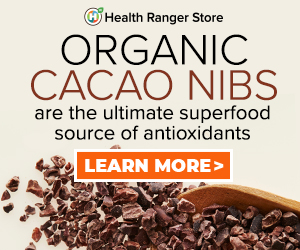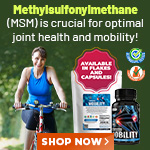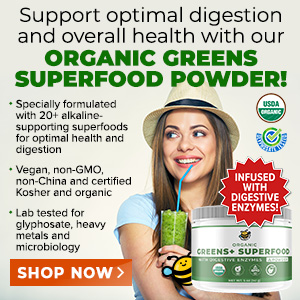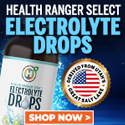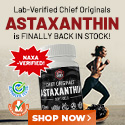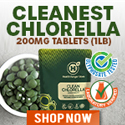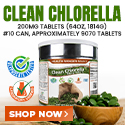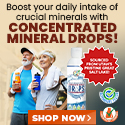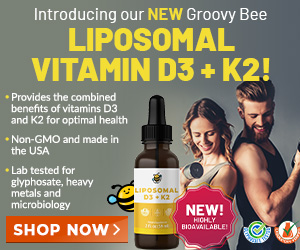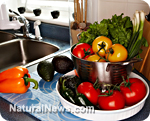
How to Prevent Premature Aging with Antioxidants
Monday, October 27, 2008 by: Teya Skae
Tags: antioxidants, health news, Natural News
- The hidden war above: Chemtrails, HAARP and the battle for planetary control
- Florida Senate passes bill banning geoengineering and weather modification and Governor DeSantis has indicated it will become law
- Hidden toll: Federal secrecy shields wind industry's eagle deaths to protect land-hungry turbines that yield minimal power
- CLOT SHOT PLANDEMIC UNFOLDING: Fibrous, rubbery clots caused by covid injections have prion-like seeding activity
- 7 Must-have multi-functional survival tools for every prepper
- DEATH by VACCINE or face PRISON time: Canadian Freedom Convoy leaders CONVICTED for protesting forced vaccination during the Covid Plandemic
- George Floyd double standard: White 4.0 athlete slaughtered by Black teen-media silent
- Aerosolized bioweapons? Strange “diploid biomasses” falling out of the sky in Florida captured under the microscope
- Putin launches largest military call-up since 2011 amid escalating tensions
- Global pedophile ring “Kidflix” shut down in landmark Europol operation
- Idaho Gov. Brad Little vetoes Medical Freedom Act
- Chief Justice Roberts faces scrutiny over ties to anti-Trump legal strategist Norm Eisen
- Widespread social and economic unrest: Steve Quayle issues urgent financial warning of imminent asset collapse in new interview with Mike Adams
- The Trump effect: RECORD LOW in illegal border crossings signals a new era of border security
- ChatGPT’s cowardly DOUBLE STANDARD: Bowing before Islam while mocking Christianity
- Science unlocks nature’s potential: How natural compounds may support individuals with Autism Spectrum Disorder (ASD)
- Top German general admits that CONSCRIPTION is “absolutely” necessary to combat Russia
- Analysis: The coming economic collapse, a mass uprising and Trump's three secret weapons to halt the growing revolt
- Newly released JFK files reveal Pentagon's role in creating Lyme disease and covid in the same lab
- European Court of Justice: Healthcare professionals who promoted or administered COVID-19 vaccines are CRIMINALLY LIABLE for any harm caused
- Aerosolized bioweapons? Strange “diploid biomasses” falling out of the sky in Florida captured under the microscope
- Oncologist warns of ‘terrifyingly aggressive’ cancers in children, linked to immune suppression from COVID vaccines
- Britain’s descent into police state censorship: Parents raided for questioning their daughter’s school system online
- Analysis: The coming economic collapse, a mass uprising and Trump's three secret weapons to halt the growing revolt
- Utah governor allows ban on LGBT pride flags in public buildings and schools, will take effect without his signature
- Kiss Your Genetic Privacy Good-Bye! 23andMe Gets Green Light to Sell Your Intimate Genetic Details to Anyone They Want
- FBI imposed gag order on agents to silence Hunter Biden laptop truth before 2020 election, new chat logs reveal
- The Health Ranger releases “Vaccine Zombie” song and music video, using AI-animated zombies for the music video
- DARPA: The shadowy innovator behind the world’s most advanced military technologies
- Mike Adams releases country western hit single: Goin’ Back in Time is Comin’ Home
- “Project Aldrin”: Senate probes Meta's alleged censorship dealings with China
- When antibiotics are unavailable, natural ANTIMICROBIAL compounds become essential first line defenses against infection
- AI-powered forecasting model proves more accurate than traditional systems at predicting the weather
- German researchers find link between mRNA vaccines and GENETIC CHANGES that precede CANCER and AUTOIMMUNE DISORDERS
- Dr. Mary Talley Bowden drops bombshells about children being permanently damaged by mRNA jabs during Tucker Carlson interview
- Ancient kitchen secrets REVEALED: How garlic, ginger and green onions fight cancer and heart disease
- Newly released JFK files reveal Pentagon's role in creating Lyme disease and covid in the same lab
- California's social media censorship law struck down: A victory for free speech or a threat to online safety?
- The Health Ranger releases “Vaccine Zombie” song and music video, using AI-animated zombies for the music video
- Dr. Mike Yeadon releases 15-minute testimony - WATCH - about genocidal intent of COVID “vaccines”
- EPA advisor admits the agency is funneling billions to climate groups ahead of Trump’s return to White House
- Rep. Nancy Mace introduces bill to ban biological males from female facilities on federal property
- Florida takes a stand: DeSantis proposes permanent ban on mRNA vaccine mandates
- Sugarcane extract superior to cholesterol-lowering drugs?
- Survival 101: Effective EMF blocking techniques
- Mike Adams releases country western hit single: Goin’ Back in Time is Comin’ Home
- OpenAI whistleblower who dissented against how the company trained ChatGPT found dead
- Attorney and TikTok influencer explains how he was offered hundreds of dollars to make false claims about Trump, Republicans
- CONSERVATIVES SOUND THE ALARM: Big Pharma and the Left trying to force $32 billion money grab from America’s seniors into year-end spending deal
- Pilots report mysterious lights 'moving at extreme speeds' across Oregon skies
- Trump expected to choose Kelly Loeffler as his agriculture secretary even though she was caught INSIDER TRADING during COVID
- Marketing director responsible for WOKE Jaguar rebrand is also an LGBT activist who supports Black Lives Matter
- Unpacking the Lies That We’ve Been Fed – new song and music video released by Mike Adams, the Health Ranger
- Poll: Majority of Ukrainians want peace negotiations to end war with Russia
- Red Cross issues warning to stop blood plasma donations from vaccinated people
- Scientists confirm: GENIUS brain function can be spontaneously unleashed in humans without any apparent cause
- EPA advisor admits the agency is funneling billions to climate groups ahead of Trump’s return to White House
- HYSSOP: What research reveals about the health benefits of this ancient holy herb
- Two containers with completed ballots fall out of truck in Florida
- Fully vaccinated about to see “tsunami” of illness and death, warns virologist
- Global leaders unite to clamp down on “misinformation” with UN-backed Cascais Declaration
- BREAKING: 2025 NDAA authorizes mandatory military draft of WOMEN across America… as Pentagon pursues global NUCLEAR war with both Russia and China at the same time
- Newly released JFK files reveal Pentagon's role in creating Lyme disease and covid in the same lab
- Michael Yon warns of a ZIONIST TAKEOVER in Trump’s second administration
- BOMBSHELL: DNA testing kits are a SCAM to develop ethnic-specific bioweapons
- Ozempic and Wegovy weight loss drugs are injectable LIZARD VENOM PEPTIDES that may unleash a devastating wave of organ failure… side effects align with symptoms of SNAKE BITES
- The Health Ranger releases “Vaccine Zombie” song and music video, using AI-animated zombies for the music video
- Israeli soldiers accused of even more torture and abuse in the West Bank
- These 13 countries just signed an agreement to engineer a global FAMINE by destroying food supply
- NASA admits that climate change occurs because of changes in Earth’s solar orbit, and NOT because of SUVs and fossil fuels
- RFK Jr. clears key hurdle: Sen. Susan Collins backs controversial HHS nominee, signaling a new era for health policy
- Sermon 30: How Jesus reveals Caesar’s FAKE CURRENCY and FALSE AUTHORITY
The rate at which we oxidise is the rate at which we age.
What do we mean by oxidise?
Oxygen is essential for basic cell-function in humans and most animals. However, research is showing that oxygen can produce toxic substances, such as peroxide, superoxide, hydroxyl radicals, and "excited stage oxygen". These highly reactive substances combine with other molecules in the body with destructive effects. They form "free-radicals', which are high-energy chemical substances 'looking' for something to combine with. This is known as free-radical damage or oxidisation.
Oxidisation occurs when an excess of oxygen in our bodies (from exercise or metabolic processes) causes the rapid production of free-radicals and the body's supply of antioxidants is not enough to counteract this reaction, once it has started.
Research has shown that free-radical reactions in our bodies are responsible for inflammation, ageing, drug-induced damage, degenerative arthritis, alterations in immunity, cancer and cardiovascular disease.
Free Radicals Are the Cause of Oxidative Stress
Some free-radicals are generated from normal body functions like breathing, metabolism, digesting polyunsaturated fats and physical activity. Others are created by the immune system to neutralize viruses and bacteria.
What Causes Free-Radicals to Form?
* Exercise, particularly aerobic or any cardiovascular exercise, produces a lot of free radicals and oxidisation.
* Eating polyunsaturated fats. (Yes, the ones that were once considered to be healthy!)
* Consuming trans-fatty acids, such as all margarines, olive oil based spreads, and heart health spreads made with polyunsaturated oils.
* Cooking with fats, particularly POLYUNSATURATED oils - and even Olive Oil. All fats oxidise, with the exception of Virgin Coconut Oil.
* Smoking.
* Alcohol.
* Lack of sleep.
* Everyday toxins (from foods, pesticides, herbicides, chemicals and additives.
* Pollution (such as petrol and exhaust fumes),
* Electro-magnetic Radiation.
* Stress - both emotional and physical
In order to appreciate how antioxidants help counteract free-radicals, here's a quick overview of chemistry/physiology 101.
The human body is composed of different types of cells. Cells are made up of many different types of molecules. Molecules consist of one or more atoms, of one or more elements, joined by chemical bonds.
Atoms are comprised of a nucleus, neutrons, protons and electrons. The number of protons (positively charged particles) in the atom's nucleus determines the number of electrons (negatively charged particles) surrounding the atom. Electrons are involved in chemical reactions and their attraction for each other forms the bonds that 'glue' atoms together to form molecules. Electrons surround or "orbit" an atom in one or more shells. The innermost shell is complete when it has two electrons. When the first shell is full, electrons begin to fill the second shell. When the second shell has eight electrons, it is full, and so on.
The most important structural feature of an atom for determining its chemical behaviour is the number of electrons in its outer shell. A substance that has a full outer shell is considered stable or 'inert', and won't enter into chemical reactions. Because atoms 'seek' to reach a state of maximum stability, an atom will attempt to fill its outer shell by:
•gaining or losing electrons to either fill or empty its outer
shell
•sharing its electrons by bonding together with other atoms
in order to complete its outer shell
Often atoms complete their outer shells by sharing electrons with other atoms. By sharing electrons, the atoms bond together and fulfil the conditions for maximum stability for the molecule.
What are Free-Radicals
Free-radicals are highly reactive molecules that are produced simultaneously when the body burns oxygen to produce energy, such as during exercise or in the process of metabolising fats. Free-radicals are single atoms with unpaired electrons, "looking for a mate". A molecule that's missing an electron is not a happy molecule. So, rather than just accept its path of being single, it steals another electron from the first thing it encounters. As free-radicals do not have any discriminating ability, they will steal an electron from the first thing they encounter. This may be a cell wall from arteries, or a strand of DNA, or anything else it encounters in its attempt to pair up with another electron.
This process continues until two free-radicals meet and react, satisfying their lone electrons. Even though this might be a satisfying outcome for the two lone electrons, their union has left a trail of destruction, causing prolific cell damage to other cells, left beyond repair.
As free-radical damage mounts, affected cells can no longer perform properly. Tissues degrade and, in time, disease sets in. An excess of free radicals has been cited in the development of cardiovascular disease, Alzheimer's, Parkinson's and cancer. Aging, itself, has been defined as a gradual accumulation of free-radical damage.
How can we prevent Free-Radical Damage?
There are two solutions. The first and most obvious is to avoid the causes of free-radical damage, such as by avoiding the use of all polyunsaturated fats in cooking and use saturated fats, such as virgin coconut oil, which never oxidizes. In addition, eliminate toxins from our diet and lifestyle. Yet, even if we do all these things, we will still encounter free-radical damage due to the fact that we need oxygen and we need to exercise - and that produces a lot of free radical stress. The second solution is to rely on the help of Mother Nature by obtaining ANTIOXIDANTS from our food.
Normally the body can handle free radicals but, if the supply of antioxidants is insufficient, free-radical production becomes excessive with resulting damage to cells and tissues.
What are Antioxidants?
Antioxidants are molecules that come from nature, which neutralize free-radicals by donating one of their own electrons, ending the "electron-stealing" behaviour of the free-radicals. The antioxidant nutrients themselves don't become free-radicals in the process of donating an electron because they are stable in either form. They act as scavengers, helping to prevent cell and tissue damage that could lead to cellular damage and disease.
You can see antioxidants at work in your own kitchen. Slice an apple in half and watch it turn brown. That's oxidation, due to oxygen reacting with the apple creating free-radicals.
If, however, you dip the apple in some lemon juice, the rate at which the apple turns brown is slowed down because the vitamin C in the lemon juice decreases the rate of free radical activity taking place.
Since the body cannot manufacture antioxidants, these very important molecules need to come from our diet and the right supplements.
We now know that to minimise free-radical damage – which, in essence, is premature ageing - we need to include an adequate supply of antioxidants in our diet, on a daily basis. There are two categories of antioxidants: water soluble, such as Vitamin C, and fat soluble, such as vitamins A and E.
Vitamin C is the most abundant water-soluble antioxidant in the body. It acts primarily in cellular fluid and helps return vitamin E to its active form. It is found in citrus fruits, blackcurrants, berries, guavas and peppers as some of its main sources.
Vitamin A and, to lesser degree, Beta Carotene (vegetable form of vitamin A) are essential in keeping the mucous membranes that line all the cavities of our bodies in a healthy condition.
It is highly recommended that vitamin A be consumed from the diet rather than from supplements (particularly in the case of beta carotene), as it offers maximal potential for health benefits, which supplements cannot. The richest sources of vitamin A are liver, cod liver oil, butter, and egg yolks.
Vitamin A is also found in a variety of dark green and deep orange fruits and vegetables, such as carrots, sweet potatoes, pumpkin, spinach, butternut squash, turnip greens, mustard greens, and romaine lettuce. Beta carotene is the most active carotenoid (the red, orange, and yellow pigments) form of vitamin A, but it is inefficiently absorbed by the human body and is converted to retinol, which does not happen to vitamin A derived from animal sources.
Vitamin E (d-alpha tocopherol) is the most abundant fat-soluble antioxidant in the body and is one of the most efficient antioxidants available. It is also a primary defender against fat oxidation. It is found in nuts, some seeds, peas and wheat germ.
So, if you eat enough of foods that contain these vitamins, would that be sufficient antioxidant intake? Not quite. For a start, eating a lot of fruit would hinder the benefits, as fruits contain high amounts of sugar in the form of fructose and the liver does not digest fructose easily. Very small amounts are okay, but any more than 2 pieces of fruit daily would be too much fructose, which would burden the liver and also cause bloating. This is why most people do not do well on fruit juices, as fruit juices cause low-blood sugar, leading to cravings. In addition, if the sources are not organic, then we are adding to free-radical damage by ingesting pesticides and chemicals, which is a feature of a high non-organic, vegetable/fruit diet.
Is there a system that we can rely on for validating some of these health claims in our attempts to find the right antioxidants?
Yes, there is. It is called the ORAC Scale (Oxygen Radical Absorbency Capacity).
A new test developed by Brunswick Labs (partially funded by a grant from the U.S. Department of Agriculture) can determine the capacity of a substance to protect against the most abundant free radical in the body – 'superoxide". There are four known ORAC scales (S-ORAC, ORAC, H-ORAC, N-ORAC) and they vary in results because they measure different volumes/capacities. Some companies use the ORAC scale comparisons based on units per litre, while others measure comparisons by ounces. The figures, if not properly compared, may add to the confusion.
While scientists have not been able to identify all the different phytochemical antioxidants in fruits or vegetables, the ORAC method estimates the overall antioxidant potential of the plant food. Plants with higher ORAC numbers have a greater antioxidant potential. For example, pomegranates and blueberries have been shown to have a very high ORAC (antioxidant) number. This ORAC table allows us to see the bigger picture as to which foods/supplements have the most powerful antioxidant capacity:
ORAC (Antioxidant) Units of Selected Foods/Essential Oils/Supplements
Food/SupplementORAC Units/100g
Clove Oil10,786,875
Vitamin C189,000
Thyme Oil159,590
Oregano Oil153,007
Vitamin E135,000
Ningxia Goji Berries25,300
Ningxia Wolfberry Juice4,320
Pomegranates3,307
Raisins2,830
Blueberries2,400
Blackberries2,036
Garlic1,939
Kale1,770
Cranberries1,750
Strawberries1,540
Tahitian Noni Juice1,506
Spinach1,260
Raspberries1,220
Yellow Squash1,150
Brussels sprouts980
Plums949
Alfalfa sprouts930
Steamed Spinach909
Broccoli Flowers890
Beets840
Grapes, Red739
Red bell pepper710
Cherries670
Kiwi fruit610
Source: http://optimalhealth.cia.com.au/OracLevels.h...
We need approximately 5000 ORAC scale units of bio-available antioxidants daily as a minimum to cope with the average rate of oxidation. If we exercise, drink alcohol or for those who have diabetes and/or live a busy/stressful life, then that amount needs to be doubled or tripled. This might be quite difficult to do. Consuming 2 punnets of organic blueberries and 250g of raisins daily would be a physical challenge - not to mention quite expensive intake of fruit sugar!
The solution is found in "super-foods" and super-supplements
One of the best known super-foods on this planet is Ningxia's Goji berries. There are at least 17 species of Wolfberries and not all are the same. The best source - and the highest on the ORAC scale (25,300 per 100gr) - comes from Ningxia Province in China.
As for super-supplements, organic clove oil tops the list, with 2 – 4 drops being equivalent to 10,000 - 15,000 on the ORAC scale. However, make sure the label says "100% Pure Grade-A essential oils", otherwise it will not have the therapeutic/antioxidant value it needs, to be of any benefit in our bodies.
Another fact that we need to know is that a lot of companies use chemical solvents and petrochemicals in the process of extracting essential oils. This is because distillation is a very expensive process and using chemicals speeds up the extraction time of the oil from the plant. It takes an average 12 - 24 hours to distil pure frankincense. This is very costly, which is why pure unadulterated frankincense oil is quite expensive. It is also a fact that only 2% of the world's total aromatherapy oils production is considered therapeutic and, therefore, of any benefit to us; the other 98% is synthetically/chemically derived for perfume/cosmetics companies, who are only interested in the floral tones of the oil and not its therapeutic benefits.
Another very reliable supplement is Vitamin E, which is very important to take if consuming fish oil supplements. All oils oxidise - except for Virgin Coconut Oil. Even good old Virgin Olive Oil oxidises during cooking. As fish oils also oxidise, simultaneously taking vitamin E would help prevent rancid reactions taking place in the cells. However, vitamin E is best taken in a supplement form in a dose of no more than 400IU (ORAC of 540). Higher doses are counterproductive and may even thin the blood. Relying on vitamin E from nuts is not as healthy, due to their very high content of polyunsaturated and monounsaturated fats, which means they go rancid and oxidise once in the body.
We need various "good" fats on a daily basis. For those who are on a vegetarian diet, relying on Linseed/Flaxseed oil for their intake of Omega 3's is inadequate. The Omega 3 from flax/linseed oil comes in a form of ALA (Alpha-linolenic acid) and it does not convert easily to EPA (eicosapentaenoic acid) or DHA (docosahexaenoic acid) – the oils found in fatty fish, which are essential for good heart and brain function. "The good oil" for everyone to use daily is Virgin Coconut Oil, as it is stable during cooking/baking, does not oxidise and even has antibacterial properties. For those who are concerned about it being a saturated fat, there is a lot of myths about fats and these are fully explained by Mary Enig, PhD and Sally Fallon, in the "The Oiling of America".
Dr. Ray Peat, PhD also offers a succinct explanation of the benefits of Coconut Oil over polyunsaturated oils and other unsaturated fats.
"When the oils are stored in our tissues, they are much warmer, and more directly exposed to oxygen than they would be in the seeds, and so their tendency to oxidize is very great. These oxidative processes can damage enzymes and other parts of cells, and especially their ability to produce energy. The enzymes which break down proteins are inhibited by unsaturated fats; these enzymes are needed not only for digestion, but also for production of thyroid hormones, clot removal, immunity, and the general adaptability of cells. The risks of abnormal blood clotting, inflammation, immune deficiency, shock, aging, obesity, and cancer are increased. Thyroid [hormones] and progesterone are decreased".
Coconut Oil is unique in its ability to remain stable at very high temperatures, which is why it does not oxidize. It is quickly metabolized, as it does not require the liver or gallbladder to emulsify it, and functions in some ways as an antioxidant.
We can see that, by including super-foods - such as organic Ningxia wolfberries, blueberries, raisins and other high ORAC scale foods - in our diet, we are taking the best ammunition for free-radicals and can slow the biological clock that is relentlessly ticking away our "life-time".
"The amount of antioxidants that you maintain in your body is directly proportional to how long you will live" Dr Richard Cutler, Director of Anti-Ageing Research Department of the National Institute of Health, Washington, D.C.
In Wellness!
Teya Skae
References:
Dr Ray Peat PhD http://www.efn.org/~raypeat/
Mary G. Enig, PhD Know Your Fats: The Complete Primer for Understanding the Nutrition of Fats, Oils, and Cholesterol, Bethesda Press, May 2000. www.enig.com/trans.html.
Mary Enig, PhD and Sally Fallon,"The Oiling of America." http://www.westonaprice.org/knowyourfats/oil...
Uffe Ravnskov, MD, PhD, The Cholesterol Myths: Exposing the Fallacy that Cholesterol and Saturated Fat Cause Heart Disease, New Trends Publishing, Washington, DC, 2000. More info online at: www.ravnskov.nu/cholesterol.htm
About the author
Teya Skae M.A. ATMSCorporate Wellness Presenter/Researcher and Author
As the founder of Empowered Living Teya has developed a results based I.D.E.A.L Solutions for increasing your energy, focus and personal Success!
Teya is also a QUIT smoking specialist with proven results in one session guaranteed.
For Tangible Results and Solutions to Fat Loss, Physical, Emotional and Mental Fitness visit
www.empowered-living.com.au
Antioxidants at FETCH.news
Get independent news alerts on natural cures, food lab tests, cannabis medicine, science, robotics, drones, privacy and more.
Take Action: Support Natural News by linking to this article from your website
Permalink to this article:
Embed article link: (copy HTML code below):
Reprinting this article:
Non-commercial use OK, cite NaturalNews.com with clickable link.
Follow Natural News on Facebook, Twitter, Google Plus, and Pinterest
Science News & Studies
Medicine News and Information
Food News & Studies
Health News & Studies
Herbs News & Information
Pollution News & Studies
Cancer News & Studies
Climate News & Studies
Survival News & Information
Gear News & Information
News covering technology, stocks, hackers, and more



"Big Tech and mainstream media are constantly trying to silence the independent voices that dare to bring you the truth about toxic food ingredients, dangerous medications and the failed, fraudulent science of the profit-driven medical establishment.
Email is one of the best ways to make sure you stay informed, without the censorship of the tech giants (Google, Apple, Facebook, Twitter, YouTube, etc.). Stay informed and you'll even likely learn information that may help save your own life."
–The Health Ranger, Mike Adams










